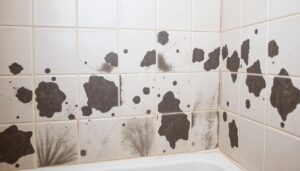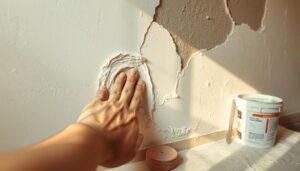Deep cracks in concrete surfaces are not just aesthetically displeasing; they can also compromise the integrity of your floor. If left untreated, these cracks can escalate into more significant problems, potentially leading to costly repairs.
Understanding the causes of cracks and the proper techniques for repair is crucial for a lasting fix. This comprehensive guide will walk you through assessing, preparing, and filling those unwanted gaps in your concrete floor, ensuring a durable and long-lasting repair.
Key Takeaways
- Assessing the crack’s severity is vital before starting the repair process.
- Proper preparation of the crack is essential for a successful repair.
- Choosing the right materials is crucial for a durable fix.
- Following expert recommendations ensures a long-lasting repair.
- Regular maintenance can prevent further deterioration of your concrete surface.
Understanding Concrete Floor Cracks
Understanding the causes of cracks in your concrete floor is crucial for effective repair. Concrete is a rigid material prone to cracking due to various factors.
Common Causes of Concrete Cracks
Concrete cracks develop due to shrinkage during the curing process, temperature fluctuations, and settlement of the ground beneath the slab. Chemical reactions, such as carbonation and sulfate attack, can also damage concrete over time.
Types of Cracks in Concrete Floors
Different types of cracks include settlement cracks caused by unstable soil, shrinkage cracks from rapid drying, and structural cracks resulting from excessive weight. Understanding the type and cause of your crack is essential for determining the appropriate repair method.
Why Repairing Deep Cracks is Essential
Deep cracks in your concrete floor can be more than just a cosmetic issue; they can signal underlying problems that need immediate attention. Cracks in concrete may be a sign of deeper underlying issues, and if left unaddressed, they can lead to bigger problems and costly repairs.
Preventing Structural Damage
Unrepaired deep cracks in concrete floors can compromise the structural integrity of your entire building. This can potentially lead to costly foundation issues and even put your home at risk of collapse. Regular inspection and repair of cracks are crucial to prevent such structural damage.
Avoiding Water Seepage and Further Deterioration
Water seepage through concrete cracks can cause significant damage, including mould growth and deterioration of the concrete. To avoid water seepage and further damage, it’s critical to seal any cracks that develop. 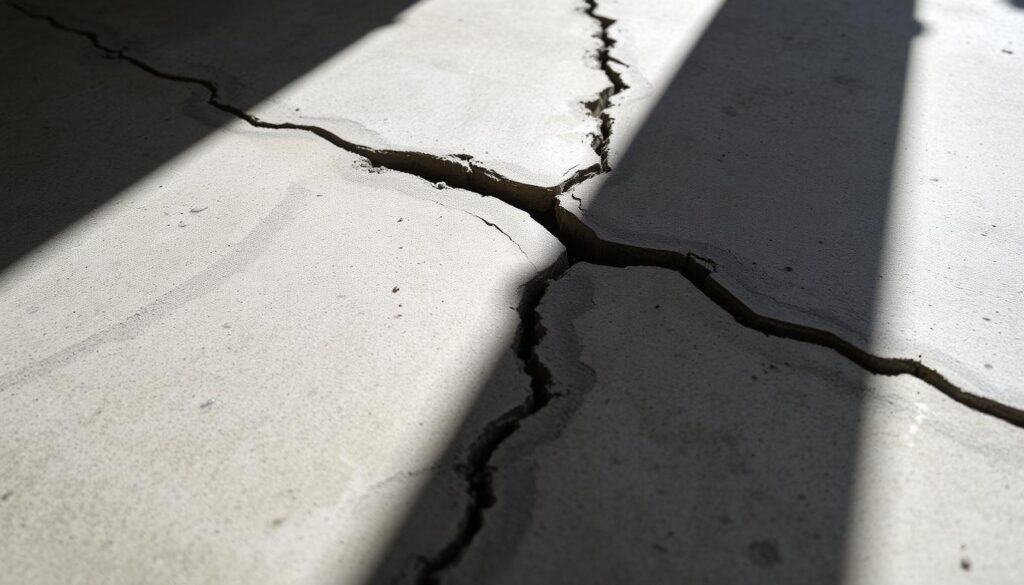 By addressing deep concrete cracks promptly, you can prevent minor issues from developing into major structural problems that require complete floor replacement.
By addressing deep concrete cracks promptly, you can prevent minor issues from developing into major structural problems that require complete floor replacement.
Repairing deep cracks in your concrete floor is essential to maintain the surface and prevent further deterioration. By doing so, you can ensure the longevity of your concrete floor and avoid costly repairs down the line.
Assessing the Severity of Concrete Floor Cracks
Assessing the severity of concrete cracks is a critical step in maintaining the integrity of your concrete floor. This process involves examining the width, depth, and pattern of the cracks to determine the appropriate repair method.
Hairline vs. Deep Cracks
Hairline cracks, typically less than 1/8 inch wide, are usually cosmetic issues that can be repaired with simple crack fillers. In contrast, deep cracks wider than 1/4 inch often indicate more serious structural problems. The size and depth of the crack are crucial in determining the repair strategy.
When to Call a Professional
You should consider calling a professional if you notice cracks wider than 1/4 inch, cracks that appear on both sides of a wall, or cracks that form a stair-step pattern. Additionally, if your floors have become noticeably uneven or you observe other signs of structural issues, such as doors that no longer close properly or windows that stick, it’s time to seek professional help.
- Assessing crack severity involves examining their width, depth, and pattern.
- Active cracks require different treatment than dormant cracks.
Tools and Materials Needed to Fill Deep Crack in Concrete Floor
To effectively fill deep cracks in concrete floors, you’ll need the right tools and materials. Filling deep cracks can be a challenging task, but with the correct equipment and supplies, you can achieve a durable and long-lasting repair.
Essential Tools for the Job
You’ll require a range of tools to prepare and fill the crack. Essential tools include a chisel, hammer, wire brush, shop vacuum, trowel, margin trowel, and protective gear such as gloves, safety goggles, and a dust mask. These tools will help you clean and prepare the crack for filling.
Choosing the Right Filler Materials
Selecting the right filler material depends on the crack’s width, depth, and location. Options include epoxy-based fillers for structural strength, polyurethane sealants for flexibility, and concrete patching compounds for general repairs. For deep cracks, consider using backing materials like foam backer rods or sand before applying the filler.
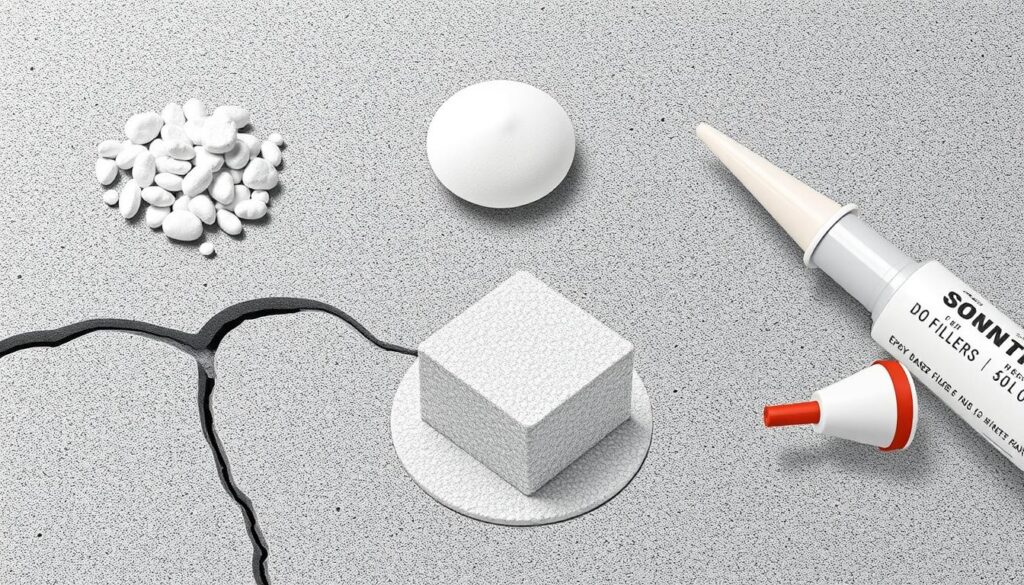
Step-by-Step Guide to Filling Deep Concrete Cracks
To repair deep concrete cracks effectively, it’s essential to follow a systematic approach that ensures a long-lasting fix. This involves several key steps that, when executed properly, result in a durable and visually appealing repair.
Preparing the Crack
Begin by preparing the crack—use a chisel and hammer to create a backward-angled cut, or an inverted V-shape, that widens the crack at the bottom. This provides a better surface area for the repair material to adhere to, enhancing the overall durability of the fix.
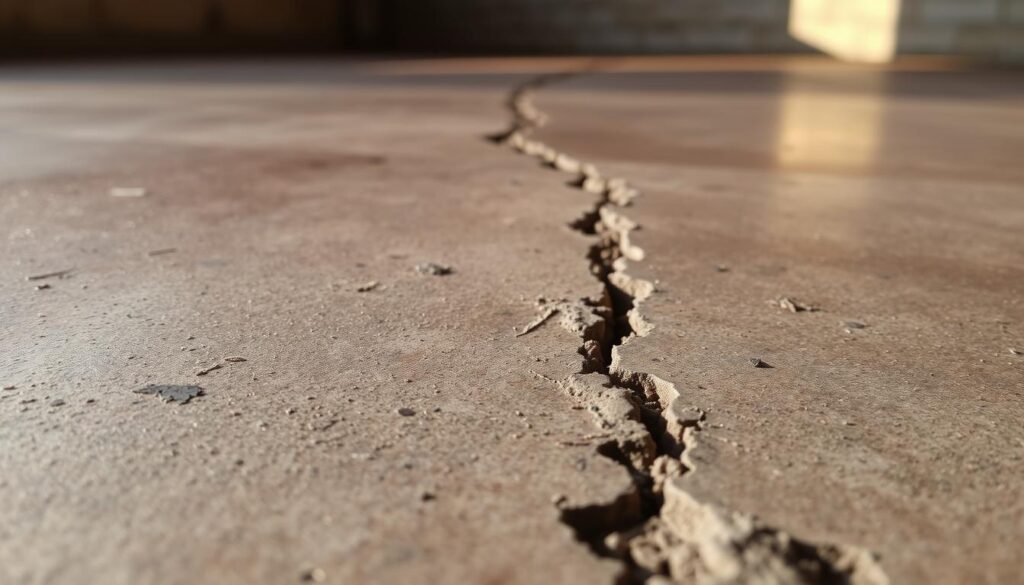
Cleaning the Area Thoroughly
Thoroughly clean the crack using a wire brush to remove loose debris and concrete. Follow this with a shop vacuum to eliminate all dust and remaining particles. Any debris left behind can prevent the filler material from bonding properly, compromising the repair.
Applying Bonding Adhesive
Apply a thin layer of bonding adhesive to the sides of the crack. This critical step, often overlooked, significantly improves the adhesion between the old concrete and the new filler material, ensuring a strong and lasting repair.
Filling the Crack Properly
For cracks deeper than 1/4 inch, insert a backer rod or sand to fill the void to within 1/4 inch of the surface. Then, mix and apply the appropriate concrete crack filler according to the manufacturer’s instructions. Slightly overfill the crack to account for shrinkage, and smooth the surface with a trowel for a professional finish.
By following these steps and using the right materials, you can achieve a successful repair that extends the life of your concrete floor. Remember, the key to a durable repair lies in the preparation and the quality of the materials used.
Best Products for Filling Deep Concrete Cracks
The right product can make all the difference in filling deep concrete cracks effectively and ensuring a long-lasting repair. When it comes to selecting a product, you need to consider the type of crack, the environmental conditions, and the desired durability of the repair.
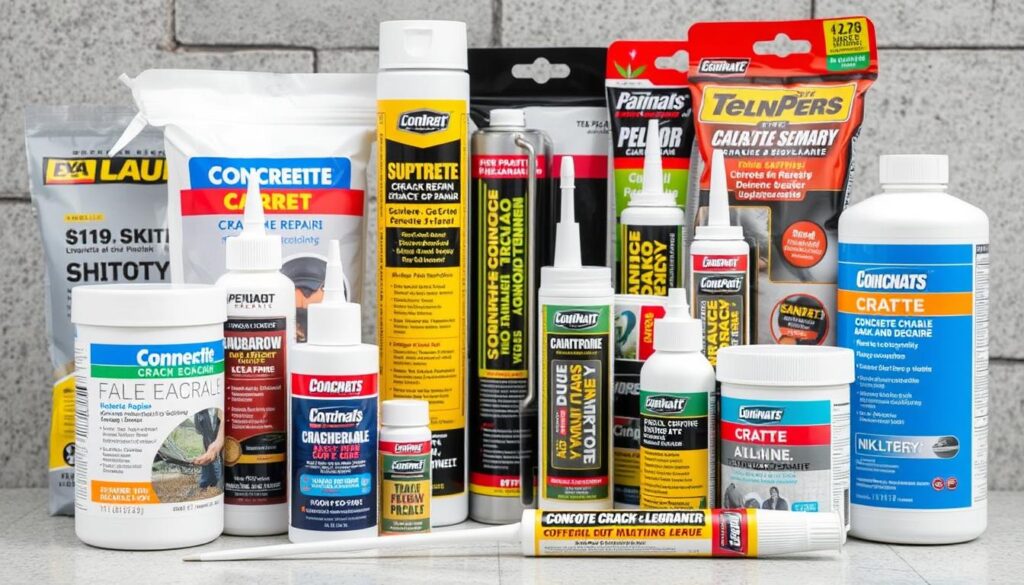
Epoxy-Based Fillers
Epoxy-based fillers provide exceptional strength and durability, making them ideal for structural repairs of deep concrete cracks. They bond strongly to the concrete, restoring the structural integrity of the floor. Products like Resincoat Epoxy Crack Repair Filler are ultra-strong and pourable, suitable for fine cracks in concrete, brickwork, or stone surfaces.
Polyurethane Sealants
Polyurethane sealants offer excellent flexibility, allowing them to expand and contract with the concrete during temperature changes. This makes them particularly suitable for cracks in areas subject to movement or vibration. Resincoat Polyurea Joint Sealant is a high-quality, flexible polyurea sealer that can easily fill joints and cracks in concrete and other surfaces.
Concrete Patching Compounds
Concrete patching compounds are versatile general-purpose fillers that work well for most deep crack repairs. They typically come pre-mixed or as a two-part system and can be easily applied with basic tools. For very deep cracks, consider specialised deep-fill products that can be poured into the void and self-level, such as Resincoat’s Deep Fill Epoxy Concrete Repair Mortar, which cures harder than the surrounding concrete.
When selecting a product, consider factors such as cure time, weather resistance, and whether the repaired area will be subject to vehicle traffic or chemical exposure. Premium products may cost more initially but often provide longer-lasting repairs.
Advanced Techniques for Very Deep Cracks
When dealing with very deep cracks in concrete floors, advanced techniques are necessary to ensure a durable repair. Very deep cracks can be challenging to fill effectively, but with the right methods, you can achieve a long-lasting result.
Using Backer Rods for Deep Voids
For very deep cracks (deeper than 1/2 inch), backer rods are essential. These foam cylinders are inserted into the crack to provide support for the filler material and reduce the amount of expensive filler needed. The backer rod should be approximately 25% larger than the width of the crack to ensure it stays firmly in place. Press it into the crack using a blunt tool until it sits approximately 1/4 inch below the surface.
Multi-Layer Filling Approach
A multi-layer filling approach is often necessary for extremely deep cracks. Begin with a base layer of sand or gravel for the deepest portion, followed by a backer rod, then apply the actual crack filler in stages. When filling very deep cracks in multiple layers, allow each layer to cure according to the manufacturer’s instructions before applying the next layer. This prevents trapping moisture and ensures proper curing throughout the repair.
Tips for Ensuring a Long-Lasting Repair
A successful concrete crack repair isn’t just about filling the gap; it’s about making sure the fix lasts. To achieve a durable repair, you need to consider several factors, including the materials used and the environmental conditions.
Proper Curing Time
Allowing the repair to cure properly is crucial for its longevity. Follow the manufacturer’s instructions regarding curing time to avoid compromising the repair. Weather conditions, such as cold or humid environments, can significantly impact curing times, so it’s essential to adjust your expectations accordingly.
- Be patient and avoid rushing the curing process by exposing the repair to foot or vehicle traffic too soon.
- Consider the weather conditions and their potential impact on the curing time.
Sealing the Repaired Area
After the crack filler has fully cured, apply a concrete sealer over the repaired area to provide additional protection against moisture, chemicals, and wear. This extra step greatly extends the life of the repair.
| Benefits of Sealing | Description |
|---|---|
| Moisture Protection | Prevents water from seeping into the concrete |
| Chemical Resistance | Protects against chemical damage |
| Wear Resistance | Reduces the impact of wear and tear on the repaired area |
Regularly monitoring the repaired area for signs of failure, such as the filler pulling away from the edges or new cracks forming nearby, is also crucial. For floors subject to heavy use or extreme conditions, consider applying a complete concrete floor coating system after repairing all cracks.
Conclusion
With the right techniques and materials, you can successfully repair deep cracks in your concrete floor. Filling deep cracks is a manageable DIY project when you understand the proper techniques and use the right sealant for the job. Taking the time to properly assess, prepare, and repair concrete cracks will save you money by preventing more serious structural issues. For very deep or uncertain cases, consider consulting a professional to ensure a lasting repair. Regular maintenance will also help extend the life of your concrete surface. For more detailed guidance, visit This Old House for expert advice on fixing cracks in concrete.


